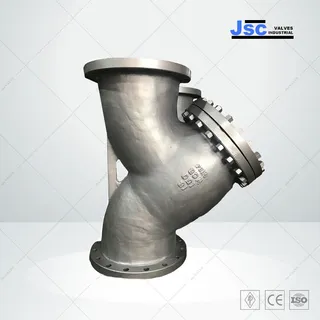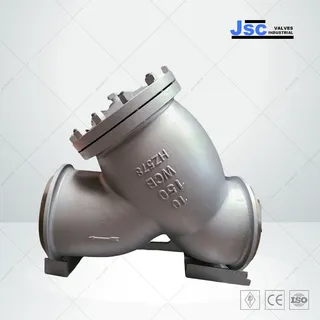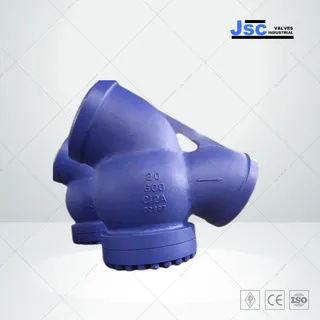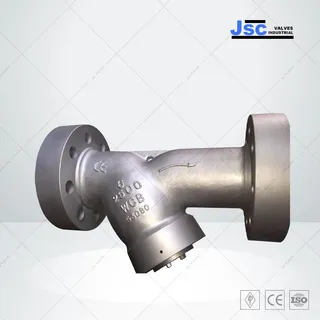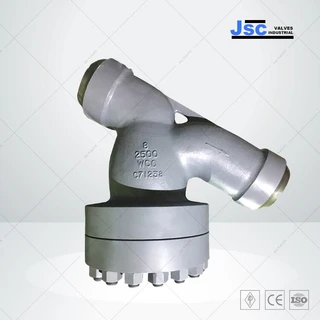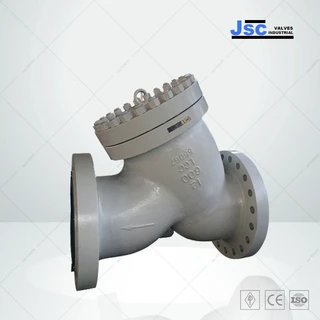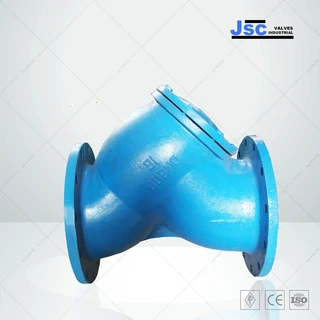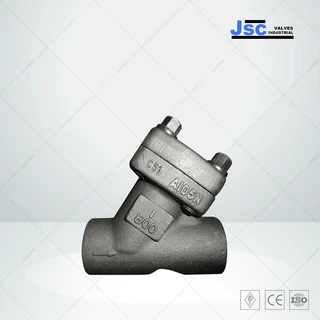Strainers
Strainers are devices used in fluid systems to remove solid particles from liquids or gases, preventing damage to downstream equipment such as pumps, valves, and instruments. They are essential components in industrial processes where the presence of contaminants can impair system performance or cause wear and tear.
8 results
JSC-240607-YS-02
Introducing our high-quality Cast Carbon Steel Y Strainer, manufactured to ASME B16.34 standards. Crafted from ASTM A216 WCB, this 18-inch strainer is designed for Class 150 LB and PN20 applications. Equipped with RF Flanged Ends for easy installation and secure connections. Featuring a durable SS 304 Screen Mesh, it effectively filters debris. Ideal for industries requiring reliable filtration in large-scale applications.
JSC-240607-YS-01
Discover our ASME B16.34 compliant Y Strainer, manufactured in our state-of-the-art plant in China. Constructed from ASTM A216 WCB, this 10-inch strainer is engineered for Class 150 LB applications. Featuring a durable SS 304 Perforated Screen, it effectively filters debris. Its double-layer net structure enhances filtration efficiency. With butt-welded ends, installation is secure and hassle-free. Ideal for industries requiring reliable filtration in demanding environments.
JSC-240524-YS-01
Discover our ASTM A217 C12A Y Strainer. Constructed from cast alloy steel, it ensures durability and reliability. Compliant with ASME B16.34 standards, it meets industry quality requirements. Sized at 20 inches (DN500) for Class 600 LB and PN100 applications, it's suitable for various industrial settings. Featuring a Stainless Steel 304 screen mesh for effective filtration, it ensures optimal performance. With butt welded ends for secure sealing, our Y strainer provides dependable filtration in critical systems.
JSC-240511-YS-01
Our ASTM A216 WCB Y strainer plant specializes in crafting robust strainers from carbon steel, adhering to ASME B16.34 standards. These strainers are designed for reliability and durability, available in a size of 6 inches (DN150) with a pressure rating of Class 2500 LB (PN420). They feature a pressure seal bonnet for enhanced sealing, an SS 304 screen mesh for effective filtration, and RTJ flanged ends for secure connections.
JSC-240418-YS-01
Discover our high-pressure Y strainer crafted from ASTM A216 WCC cast carbon steel, meeting ASME B16.34 standards. With an 8-inch (DN200) size and Class 2500 LB (PN420) rating, it ensures robust filtration and protection for industrial systems. Featuring butt-welded ends for secure installation, it effectively removes impurities, ensuring smooth and long-lasting operation.
JSC-231124-YS-116
Enhance your liquid filtration system with our ASME B16.34 Cast Steel Y Strainers. Available in sizes ranging from 1/2 to 24 inches and suitable for 150-600 LB applications, these strainers are ideal for diverse setups. Crafted from casted carbon, stainless, and alloy steel, they boast durability. The incorporation of SS 304 and SS 316 screens ensures effective filtration.
JSC-231124-YS-117
Elevate your fluid filtration game with our cast iron Y strainers. Compliant with ASME B16.34, these strainers come in sizes from 1/2 to 24 inches, ideal for Class 150 LB applications. Crafted from robust materials like Cast Iron GG25, HT250, and Ductile Iron GGG40, QT450, GGG50, they ensure durability. The SS 304 or SS 316 screen, along with RF, BW, and SW end options, makes them a reliable choice for your filtration requirements.
JSC-231124-YS-118
Source premium API 602 Y-Strainers from our reputable supplier. Crafted from forged steel, including ASTM A105N, F11, F22, LF3, F304, F316L, F304L, these strainers ensure durability and performance. Available in sizes ranging from 1/2 to 2 inches (DN15 - DN50) and designed to withstand Class 150-800 LB, each strainer features a reliable SS 304 or SS 316 screen. Elevate your industrial processes with these high-quality Y strainers.
Total 8 Records, 12 records per page
A strainer is a relatively simple device, typically consisting of several key components that work together to filter out solid particles from fluids. Here are the main components of a strainer:
Strainer Body: The primary housing containing the straining element. It is typically connected to the pipeline and provides the structural framework for the strainer assembly.
Straining Element: The component responsible for capturing and retaining solid particles. The straining element varies based on the strainer type and may be a perforated basket, screen, or mesh.
Lid or Cover: Offering access to the straining element for inspection and maintenance purposes. The lid or cover allows for easy and convenient examination of the strainer's condition.
Blowdown or Drain Connection: It enables the removal of collected debris without the need to disassemble the entire strainer. This connection facilitates the cleaning process, ensuring continuous and efficient strainer operation.
Flanged Ends: Strainers are commonly equipped with flanged connections, simplifying their installation in a pipeline. The flanged ends provide a secure and easily manageable connection method for integrating the strainer into the fluid system.
There are several types of strainers, each designed for specific applications and varying requirements. The common types of strainers include:
Basket Strainers: The most common type, featuring a perforated or mesh-lined basket housed within a strainer body. The basket is designed to be removable for easy cleaning, ensuring efficient particle removal, widely used in various industries where solid particle filtration is essential.
Y-Strainers: Y-shaped strainers with a conical or cylindrical screen positioned at a 45-degree angle to the pipeline. This strainer is suitable for applications with limited space, offering effective particle capture.
Tee Strainers: Tee-shaped strainers with a straining element across the horizontal part of the T. This strainer is commonly used in applications requiring a compact design while maintaining effective particle filtration.
Duplex Strainers: Dual-basket strainers allowing continuous operation by diverting flow to one basket while the other is cleaned or replaced. This design minimizes downtime for maintenance.
Strainers offer several advantages in fluid systems by effectively filtering out solid particles and debris. Here are some key advantages of strainers:
1. Equipment Protection: Strainers play a vital role in safeguarding downstream equipment, including pumps, valves, and meters, from damage caused by solid particles. By capturing debris, they prevent clogging and wear and tear, thereby extending the life of equipment.
2. Improved System Performance: Strainers contribute to the efficient and uninterrupted operation of fluid systems by removing contaminants from the fluid. They play a crucial role in maintaining consistent flow rates and preventing disruptions caused by blockages.
3. Reduced Maintenance Costs: Strainers help minimize maintenance costs by preventing the accumulation of debris in critical components. Regular maintenance becomes easier and less frequent when strainers are utilized to filter out solid particles.
4. Extended Equipment Life: The use of strainers minimizes the impact of abrasive particles on equipment surfaces, contributing to the extended life of valves, pumps, heat exchangers, and other components in the system.
Strainers have extensive applications in diverse industries and fluid systems, serving the essential purpose of removing solid particles and debris. Here are prevalent uses of strainers:
Water Treatment Plants: Strainers are integral in water treatment facilities, filtering impurities, debris, and solid particles from raw water before it undergoes subsequent treatment processes.
Chemical Processing Industry: In chemical processing plants, strainers safeguard pumps, valves, and other delicate equipment from damage caused by particles and contaminants present in chemical fluids.
Petrochemical Industry: Within the petrochemical sector, strainers play a crucial role in filtering solid particles and impurities from hydrocarbons, ensuring pipeline integrity and preventing damage to refining equipment.
Oil and Gas Industry: Strainers are employed in oil and gas pipelines to eliminate debris, rust, and scale, safeguarding pumps, compressors, and other downstream equipment from damage.
Power Generation: Power plants utilize strainers to filter cooling water, preventing the entry of debris into turbines and heat exchangers, thereby maintaining efficient operation.

